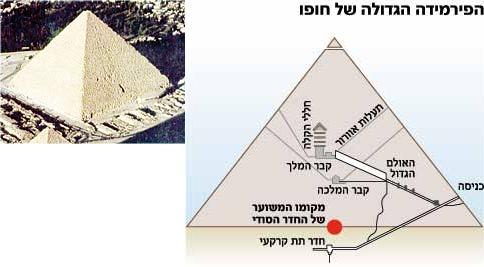The solution to the mystery of the true location of the tomb is offered by two amateur archaeologists from France, who claim that by analyzing architectural plans and using ground penetrating radar

The pyramid of Hufu
It is considered one of the Seven Wonders of the World, but it failed to fulfill its purpose and protect the treasures that were meant to reside there forever: the remains of the mummified body of King Huffo. The remains, which have never been found, were apparently taken by grave robbers. Today, 4,500 years after the construction of the Great Pyramid of Khufu was completed, it may turn out that the real tomb actually remained hidden and guarded throughout the years.
The solution to the mystery of the true location of the tomb is offered by two amateur archaeologists from France, who claim that with the help of analyzing architectural plans and using ground penetrating radar, they managed to discover a secret corridor to the pyramid, which they believe leads directly to the burial chamber of Hufo. If he does exist, there is no fear that someone took his remains. But the two - the architect Gilles Dormion and the retired real estate agent Jean-Yves Verdor - have not yet received permission from the Council of the Antiquities Authority of Egypt to check their discoveries and prove that the room does indeed exist.
"To do this, we will simply thread an optical fiber through the holes in the stone, to see if there are any gate stones in the lower corridor," Verdor said. "Then we will have to enter the front part of the corridor and enter the room, taking care to prevent contamination." The gate stones the two are looking for are large blocks of granite, which the ancient Egyptians lowered with the help of ropes into the vestibule leading to the burial chamber, to seal the chamber after the burial.
Verdor and Dormion are not just amateurs. They have been working in the pyramid for twenty years, and in 2000 they already uncovered two rooms in the destroyed pyramid in Maidum, with the help of radar analysis. Jean-Pierre Cortejani, a well-known Egyptologist from the French Institute of Oriental Archeology in Cairo, was also impressed by their work. The approximate location of the secret chamber arouses his curiosity in particular - if the two are right, it is located below and to the west of the queen's chamber, at the point of intersection of the diagonals of the pyramid. Such a place may well symbolize the resting place of King Khopo.
But not everyone is enthusiastic about the new theory. "I find it hard to believe that the Hufu burial chamber would be found in a pyramid," said Aidan Dodson, an expert in Egyptian burial archeology at the University of Bristol. "From an architectural point of view, there is no reason for a vestibule under the queen's room. The location of the burial chamber has been known since time immemorial." But the two French have a challenging idea: in their opinion, the internal structure of the pyramid was not built according to a plan, but with improvisation and corrections.
Today, three rooms are known in the pyramid. An underground space that was never used, the room erroneously called the Queen's Chamber, although in fact it is known to be intended to store the King's funeral gifts, and above it the King's Chamber, where an empty granite sarcophagus is found. It is common to assume that the mummified body of Hufu was placed in the empty coffin. Verdor and Dormion, on the other hand, claim that the architects realized that the burial chambers would not be able to bear the weight above them, and erected another chamber in its place.
To prevent the collapse of the king's burial chamber, heavy granite slabs were erected above it, with empty spaces between them. These intervals were supposed to relieve the burden of the pyramid on the ceiling of the room. But the granite walls were cracked. Geoffrey Spencer, deputy curator of the Ancient Egypt and Sudan department at the British Museum, said it was likely that the cracks in the slabs were caused by an earthquake, which occurred long after the pyramids were built. Dorion, on the other hand, claims that the accident occurred "during construction, in the eyes of the builders and with their knowledge." As evidence, he presents a 4,500-year-old block of plaster, which was used to fill the cracks.
"In the end," Dormion writes, "the puzzle of the Great Pyramid can be summed up like this: there were three burial chambers on its shore. The first was not finished building, the second was ready for use and the third was cracked. That's why his wife was buried in the second room." And perhaps the king was buried under the second room, because the entrance to the queen's room was not wide enough to pass the huge coffin made of stone, which his wife ordered for himself.

One response
Idiots, the pyramids were never meant to be used as tombs,
How many keyboards can we sell you?